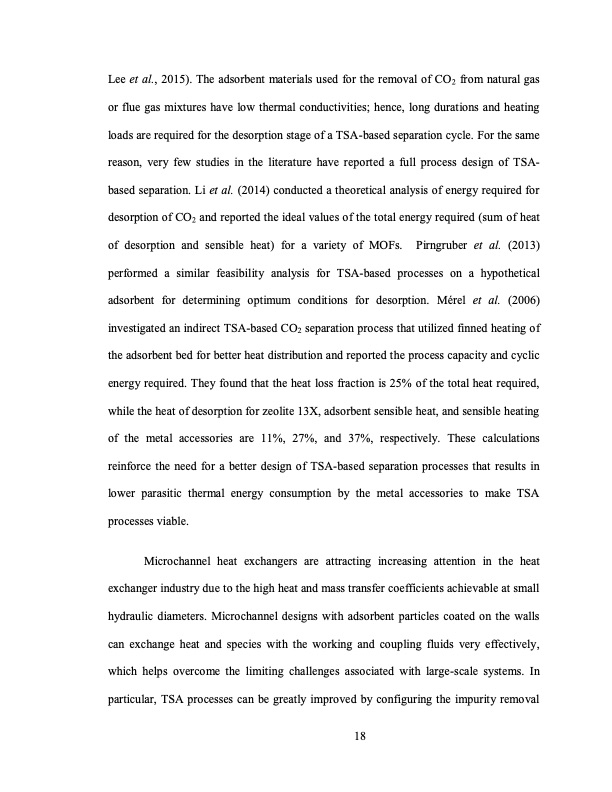
PDF Publication Title:
Text from PDF Page: 045
Lee et al., 2015). The adsorbent materials used for the removal of CO2 from natural gas or flue gas mixtures have low thermal conductivities; hence, long durations and heating loads are required for the desorption stage of a TSA-based separation cycle. For the same reason, very few studies in the literature have reported a full process design of TSA- based separation. Li et al. (2014) conducted a theoretical analysis of energy required for desorption of CO2 and reported the ideal values of the total energy required (sum of heat of desorption and sensible heat) for a variety of MOFs. Pirngruber et al. (2013) performed a similar feasibility analysis for TSA-based processes on a hypothetical adsorbent for determining optimum conditions for desorption. Mérel et al. (2006) investigated an indirect TSA-based CO2 separation process that utilized finned heating of the adsorbent bed for better heat distribution and reported the process capacity and cyclic energy required. They found that the heat loss fraction is 25% of the total heat required, while the heat of desorption for zeolite 13X, adsorbent sensible heat, and sensible heating of the metal accessories are 11%, 27%, and 37%, respectively. These calculations reinforce the need for a better design of TSA-based separation processes that results in lower parasitic thermal energy consumption by the metal accessories to make TSA processes viable. Microchannel heat exchangers are attracting increasing attention in the heat exchanger industry due to the high heat and mass transfer coefficients achievable at small hydraulic diameters. Microchannel designs with adsorbent particles coated on the walls can exchange heat and species with the working and coupling fluids very effectively, which helps overcome the limiting challenges associated with large-scale systems. In particular, TSA processes can be greatly improved by configuring the impurity removal 18PDF Image | TEMPERATURE SWING ADSORPTION PROCESSES FOR GAS SEPARATION

PDF Search Title:
TEMPERATURE SWING ADSORPTION PROCESSES FOR GAS SEPARATIONOriginal File Name Searched:
PAHINKAR-DISSERTATION-2016.pdfDIY PDF Search: Google It | Yahoo | Bing
CO2 Organic Rankine Cycle Experimenter Platform The supercritical CO2 phase change system is both a heat pump and organic rankine cycle which can be used for those purposes and as a supercritical extractor for advanced subcritical and supercritical extraction technology. Uses include producing nanoparticles, precious metal CO2 extraction, lithium battery recycling, and other applications... More Info
Heat Pumps CO2 ORC Heat Pump System Platform More Info
| CONTACT TEL: 608-238-6001 Email: greg@infinityturbine.com | RSS | AMP |